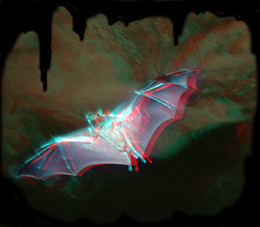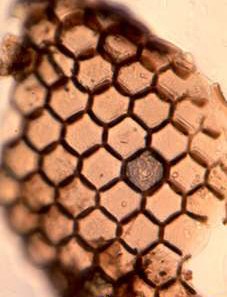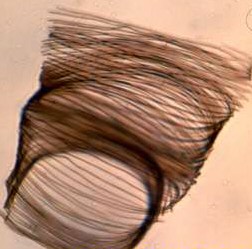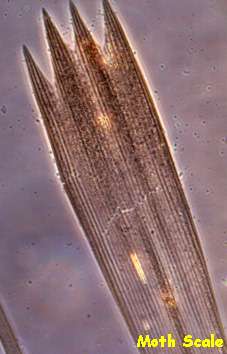Making a Study of Bat Droppings. Text By Brian Darnton (GB) Images by Jan Parmentier (NL) and Wim van Egmond (NL) |
 View bat with 3D specs |
Making a Study of Bat Droppings. Text By Brian Darnton (GB) Images by Jan Parmentier (NL) and Wim van Egmond (NL) |
 View bat with 3D specs |
INTRODUCTION.
 The
subject of collecting anything so revolting as droppings might at
first seem repugnant to the amateur microscopist, but I can
assure you that it is a very compelling and interesting activity.
Before becoming involved it's a good idea to contact your local
bat experts who will acquaint you with the rules of law. These
have been introduced to protect bats generally in the United
Kingdom where some species are under threat. With a little good
fortune a local organisation may even collect for you in a
systematic manner. It's really a matter of laying a paper below
the roost and storing the material in a desiccated condition
month by month. The Pipistrelle is perhaps the most common bat to
deal with.
The
subject of collecting anything so revolting as droppings might at
first seem repugnant to the amateur microscopist, but I can
assure you that it is a very compelling and interesting activity.
Before becoming involved it's a good idea to contact your local
bat experts who will acquaint you with the rules of law. These
have been introduced to protect bats generally in the United
Kingdom where some species are under threat. With a little good
fortune a local organisation may even collect for you in a
systematic manner. It's really a matter of laying a paper below
the roost and storing the material in a desiccated condition
month by month. The Pipistrelle is perhaps the most common bat to
deal with.
CONTENTS.
 The most pleasant aspect of this
work is that unlike humans bats do not consume quantities of
rubbish: all their food is caught on the wing in the air, though
there is evidence of some preening, as bat hairs are a fairly
common constituent of the droppings. The greater part of the food
is pure insect matter.
The most pleasant aspect of this
work is that unlike humans bats do not consume quantities of
rubbish: all their food is caught on the wing in the air, though
there is evidence of some preening, as bat hairs are a fairly
common constituent of the droppings. The greater part of the food
is pure insect matter.
Image right: facets of an insect's compound eye.
In May a dark
colour will indicate an interest in the breeding beetles, a
lighter colour in summer demonstrates an obsession with succulent
moths. Many like the plume moths can be identified by their
characteristic scales. In September when beetles again take to
the air to find winter quarters the colour changes to dark brown
again. The droppings become a pristine record of their diet.
PROCESSING.
 The
droppings can first be divided into the months of the bat year,
and each sample can be cleaned and stored separately. The
droppings are soaked in plain warm water in a 300 micron sieve
and the sample is brushed and washed through to a 100 micron
sieve that collects the sample and allows more convenient washing
in warm water.
The
droppings can first be divided into the months of the bat year,
and each sample can be cleaned and stored separately. The
droppings are soaked in plain warm water in a 300 micron sieve
and the sample is brushed and washed through to a 100 micron
sieve that collects the sample and allows more convenient washing
in warm water.
Image right: skin and hairs of an insect.
Brushing
through the larger sieve breaks up the strings of matter cemented
by mucus and natural secretions and greatly improves the quality
and visibility of the strew as well as excluding the larger
fragments. The washed insect parts can be removed from the sieve
by a brush and stored in 50% iso-propyl alcohol in labelled tubes
if not mounted at once.
THE STREW.
 First the
slide is treated with a small smear of gum tragacanth to cement
the particles to the slide and prevent sinking if the slides are
stored later on edge. A "00" art brush can be used to
remove the debris from the sieve, and in a limited quantity of
water the strew can be arranged with the brush to cover up to the
19mm ring mark on a mounting card.
First the
slide is treated with a small smear of gum tragacanth to cement
the particles to the slide and prevent sinking if the slides are
stored later on edge. A "00" art brush can be used to
remove the debris from the sieve, and in a limited quantity of
water the strew can be arranged with the brush to cover up to the
19mm ring mark on a mounting card.
Image right: trachea of an insect.
If the debris
has been stored in the alcohol its a good idea to shake it up and
pour it back into the sieve in order to counter the effect of
uneven settlement. The slide is dried off and a few drops of
Canada Balsam or Numount is applied before the cover slip is
lowered. On a hot plate the strew should be hard enough after one
day to be cleaned off and ringed with blackened Bioseal No. 2
using alcohol as a solvent if required. Do not neglect the
labelling.
|
|
EXAMINATION.
 In
transmitted light the array of insect parts is usually extensive
and sometimes quite spectacular. Smaller jaws, claws and hairs
are well represented and tracheae are very common with their
coils of spiral reinforcement. The hexagonal facets of the insect
compound eye appear in many forms. There is a background scatter
of moth scales which become more visible if the iris is closed
down. The identification of parts can tax the expert equally as
well as the amateur. Systematic collection week by week helps
identification by eliminating the options to what is on the wing
at any particular time period. In the Isle of Purbeck, the bat
experts seem to be busy at the moment restoring many wild areas
so that more flying insects become available to colonies under
threat. Microscopy could help to confirm the improved diet.
In
transmitted light the array of insect parts is usually extensive
and sometimes quite spectacular. Smaller jaws, claws and hairs
are well represented and tracheae are very common with their
coils of spiral reinforcement. The hexagonal facets of the insect
compound eye appear in many forms. There is a background scatter
of moth scales which become more visible if the iris is closed
down. The identification of parts can tax the expert equally as
well as the amateur. Systematic collection week by week helps
identification by eliminating the options to what is on the wing
at any particular time period. In the Isle of Purbeck, the bat
experts seem to be busy at the moment restoring many wild areas
so that more flying insects become available to colonies under
threat. Microscopy could help to confirm the improved diet.
Comments to the author Brian Darnton are welcomed.
Brian's previous articles can be found by typing 'Darnton' in the Article Library search engine, see link below.
Published in the April 1999 edition of Micscape Magazine.
Please
report any Web problems or offer general comments to the Micscape Editor,
via the contact on current Micscape Index.
Micscape is
the on-line monthly magazine of the Microscopy UK web
site at Microscopy-UK